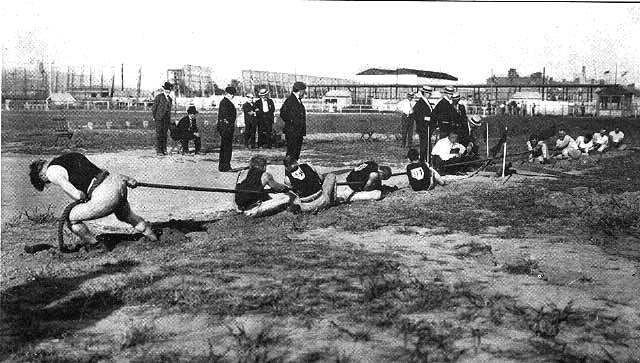Name Max Ringelmann | ||
 | ||
Born December 10, 1861, Paris, France Died May 2, 1931 (aged 69) Paris, France Nationality French Alma mater National Institute of Agronomy Known for Ringelmann effect, Ringelmann scale Institutions (Scientific career) École Nationale d’Agriculture Similar Gustave Le Bon, Leon Festinger, Fritz Heider | ||
"Ringelmann Effect" aka "Social Loafing"
Maximilien Ringelmann (December 10, 1861, Paris – May 2, 1931, Paris) was a French professor of agricultural engineering who discovered the "Ringelmann effect", viz, that when working in groups, individuals slacken.
Contents
Biography
After graduating from the public schools of Paris, Ringelmann studied at the Institute National Agronomique (National Institute of Agronomy), where he was an outstanding student. He also attended Hervé Mangon’s evening course in rural engineering at the Conservatoire National des Arts et Métiers (National Conservatory of Arts and Crafts). (Charles-François Hervé Mangon (1821–1888) had been trained as a civil engineer, but his interest shifted to agriculture, where he studied irrigation, drainage, fertilizers, etc.) Ringelmann also attended courses at the École Nationale des Ponts et Chaussées (National School of Bridges and Roads), a civil engineering school. He became an agronomic engineer in 1880. Starting in 1881, he tutored the course in rural engineering at the École Nationale d’Agriculture (National School of Agriculture) in Grand Jouan, Nozay, France. By 1883, he was contributing a weekly column to the Journal d’Agriculture Pratique (Journal of Practical Agriculture).

Up to that time, the development of agricultural machinery had been done largely by amateurs. Eugène Tisserand, a director at the Ministry of Agriculture, wanted to apply a scientific approach to the development and evaluation of farm machinery. He therefore requested that Ringelmann draft plans for a facility for testing agricultural machinery, which after many vicissitudes opened in 1888. The facility was established on Jenner Street in Paris and Ringelmann was named its director. He adapted industrial instruments where possible, but he also designed and had built instruments such as traction dynamometers, rotational dynamometers, profilographs, etc. He aimed to determine the efficiency of agricultural machinery, its economics, the quality of the work performed, etc. His wide-ranging interests soon led him to extend his research to include all branches of rural engineering: construction, drainage, irrigation, electrification, hydraulics.
In 1887, Ringelmann was elected to the Académie d’Agriculture, and in the same year, he became professor of mechanics and rural engineering at the École Nationale d’Agriculture in Grignon. In 1897, he succeeded his former professor Hervé Mangon as professor of rural engineering at the Institute National Agronomique. He became in 1902 professor of colonial rural engineering at the École Nationale Supérieure d’Agriculture Coloniale in Nogent-sur-Marne.
In 1897 he developed a simple set of grids for measuring the density of smoke, the Ringelmann scale. These grids are still used today. During 1900-1905, he wrote a monumental, four-volume study Essai sur l’Histoire du Génie Rural (Essay on the History of Rural Engineering), which traced the progress of rural engineering from pre-history to the modern age.
Ringelmann is especially notable for discovering the Ringelmann effect in 1913, also known as "social loafing". Specifically, Ringelmann had his students, individually and in groups, pull on a rope. He noticed that the effort exerted by a group was less than the sum of the efforts exerted by the students acting individually.
Original text : Pour l’emploi de l’homme, comme d’allieurs des animaux de trait, le meilleure utilisation est réalisée quand le moteur travaille seul : dès qu’on accouple deux ou plusieurs moteurs sur la même résistance, le travail utilisé de chacun d’eux, avec la même fatigue, diminue par suite du manque de simultanéité de leurs efforts …
Translation : When employing men, or draught animals, better use is achieved when the source of motive power works alone: as soon as one couples two or several such sources to the same load, the work performed by each of them, at the same level of fatigue, decreases as a result of the lack of simultaneity of their efforts …
This finding is one of the earliest discoveries in the history of social psychology, allowing Ringelmann to be described by some as a founder of Social Psychology.
Ringelmann traveled within Europe and to North America in order to observe those areas where mechanization of agriculture had progressed rapidly. He also traveled to France’s colonies—particularly in North Africa—in order to study the special problems posed by the local climate and by the pre-industrial technology that was used by the native farmers.
His expertise in agricultural engineering was sought by inventors, industrialists and farmers.
He died in Paris on May 2, 1931.
